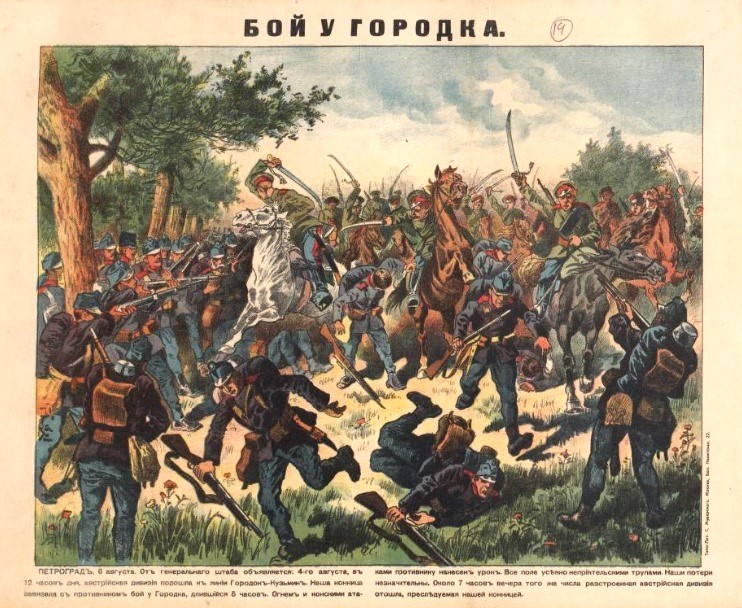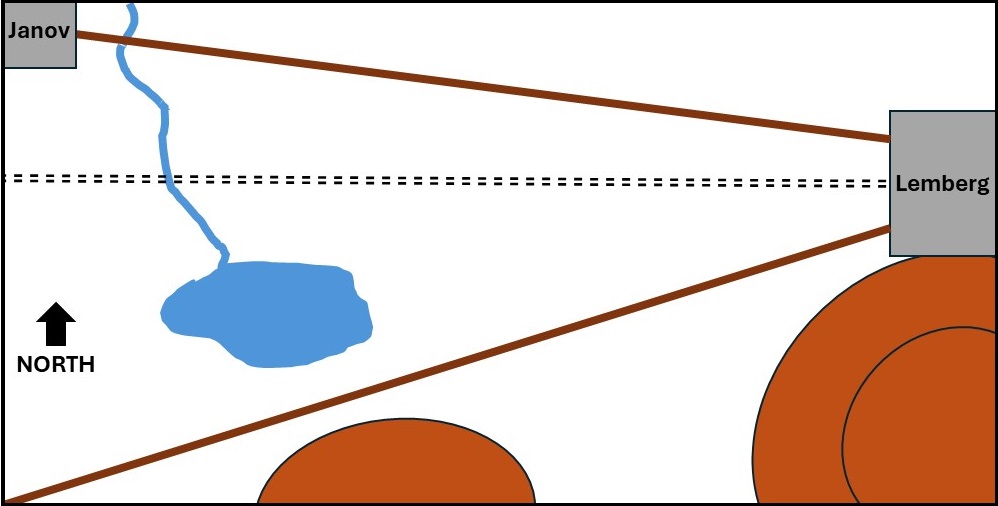Lemberg, 1914
A Scenario for Der Große Krieg

Russian cavalry routs Austro-Hungarian Landsturm near Gorodok, southwest of Lemberg.

Russian cavalry routs Austro-Hungarian Landsturm near Gorodok, southwest of Lemberg.
In late August, 1914, the Austro-Hungarian and Russian forces clashed in Galicia - the invading Russian 4th Army under Ruzsky was attacking around Lemberg, with Brudermann's 3rd Army defending Conrad's eastern flank in the same area. Historically, this resulted in the Battle of Gnila Lipa, east of Lemberg. The Austro-Hungarians were defeated, and by 30 August Brudermann was forced to retreat to the south of the city.
This scenario depicts fighting during the aftermath of that battle, as Austro-Hungarian forces make a stand near Lemberg in the face of the Russian advance, to cover Brudermann's retreat. The scenario is not strictly historical, but uses some of the forces committed, and is set in the area around which such fighting took place.
Towns are rough and will provide hard cover, but will act as roads for units in march column. The hills are rough and will provide soft cover. The rail line is a linear obstacle, and troops may find soft cover behind the embankment. The river cannot be crossed except at rail and road bridges, and the lake is impassable. (The rail line is dotted - brown solid lines are roads).

Russian forces will advance onto the table from the eastern half of the northern table edge. Austro-Hungarians will deploy first, setting up anywhere south of the rail line to the east of the river, or anywhere west of the river. Two units of any type may be entrenched in the open or on the hills (trenches count as hard cover).
Overall Commander
93rd Landsturm Brigade:
Brigade Commander
6 Landsturm Battalions @ 4 bases Reservist infantry (Landsturm Rgts. 19 and 35)
2 Field Artillery Batteries @ 1 base, may operate combined or separately
60 KuK Inf Brigade (30 Inf Div):
Brigade Commander
8 Infantry Battalions @ 4 bases Average infantry (Infantry Rgts. 30 and 80)
1 Battalion Feldjager 4 bases Veteran Infantry (Battalion 24)
2 MG Companies @ 1 base, may operate combined or separately
3 Field Artillery Batteries @ 1 base, may operate combined or separately
Overall Commander
2 Grenadier Battalions @ 4 bases Elite Infantry (5th Grenadier Rgt., attached from Grenadier Corps)
2nd Infantry Brigade, 21st Infantry Division:
Brigade Commander
8 Infantry Battalions @ 4 bases Average Infantry (81st and 82nd Infantry Rgts.)
2 MG Companies @ 1 base, may operate combined or separately
3 Field Artillery Batteries @ 1 base, may operate combined or separately (21st brigade)
Cavalry Division (3rd Caucasus Cossack Division):
Division Commander
2 Cavalry Brigades, each:
Brigade Commander
2 Cavalry Regiments @ 6 bases Average cavalry
1 Divisional MG Company @ 1 base
1 Field Artillery Battery @ 1 base
The Russians are trying to cut off the Austro-Hungarian forces. If, within 10 turns, the Russians can capture the road exiting the table on the southwestern corner, they have cut off the Austro-Hungarians and won a decisive victory. If either side destroys 40% of the units in the enemy army, rounded up, then their opponent is broken and withdraws, providing a tactical victory. (This is 9 units for the Austro-Hungarians, and 8 units for the Russians, counting artillery and MG units as operating separately.) If the Austro-Hungarians have lost 20% or less of their army at the end of 10 turns (4 units or less), that is a decisive victory for them, unless they have been cut off.
Note that Austro-Hungarians units are allowed to exit the table on the southern edge - if they do this, they may not re-enter play, but neither are they targets for the enemy. They will not count as destroyed. Russian units may delay entry onto the table for as long as desired. It is acceptable for them to assault Austro-Hungarian units within range on their turn of entry, but no firing from off-table is permitted.